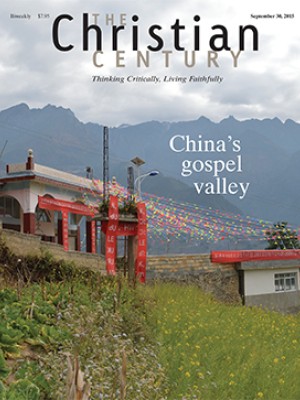Building relationships across racial lines
(The Christian Science Monitor) A low hum sweeps across the sanctuary, drifting above the bowed heads of huddled prayer groups, beyond the joined hands of black and white worshipers. Whispers carry words such as harmony, unity, forgiveness, and peace. Outside, a police car idles as day fades to dusk at Oak Mountain Presbyterian Church in Birmingham, Alabama.
The service is the product of a bond established between the mostly white Oak Mountain church and the predominantly black congregation of Urban Hope Community Church.
For pastors Alton Hardy and Bob Flayhart, the goal is to maintain that unity no matter what the circumstances.
Flayhart’s 3,000-member Oak Mountain Presbyterian Church is nestled within a zip code where 83.2 percent of the residents are white and 55.7 percent live in houses worth more than $300,000. Only 3.8 percent of families there live in poverty.
Less than ten minutes away, Hardy’s Urban Hope Community Church has a congregation that is more than 90 percent black, and more than 40 percent live below the poverty line.
The two pastors meet every Thursday for breakfast and conversation, and earlier this year they rented a 280-seat theater and brought their congregations together to watch the movie Selma. The churches have worked with other local faith-based groups on jobs programs, sustainable business plans, children’s arts camps, and prayer walks. Oak Mountain’s parishioners have been receptive and generous with resources, offering both employment and pro bono legal assistance to Urban Hope’s members.
Read our latest issue or browse back issues.
Meanwhile, Hardy and Flayhart are taking precautions to avoid what some experts call the “white savior complex,” in which well-meaning whites inadvertently try to rescue their partner churches. Hardy sees his church as a facilitator, walking beside Oak Mountain on a journey together.
“We’re giving an opportunity for people to build real, authentic relationships with people of color,” Hardy said. “It’s not like, ‘We’re going to help you because you’re poor.’ It’s more like, ‘What would it look like for African-American Christians and white Christians to build with the common denominator of Christ?’”
For his part, Flayhart is talking about race relations more than he can remember in his 26 years of ministry. In the beginning, the conversations were hard, and there were times, Flayhart admitted, that he had to have the courage to be vulnerable and say, “I don’t know what to say. I’m afraid of saying the wrong thing.”
That humility has been an important part of building authentic relationships.
“For those on the outside looking in, they’re seeing that the churches can’t even come together,” said Dion Watts, an Urban Hope member. “That’s something that has been a Goliath—a huge stumbling block. If we can come together on this, the message it will send to the rest of the world will be profound.”
Watts, who is an accountant, remembers a time in college when he was asked to house-sit in a wealthy white neighborhood. As he settled down on the couch to watch television, he saw police outside the window. When he opened the door, the officer drew his gun and told him to put his hands up and lie face down. In the distance, Watts could see two children pointing and giggling.
These are stories white people need to hear, Hardy said.
Such efforts to open lines of communication are an approach many churches are trying, from the 27-year-old Racial Reconciliation Community Outreach Network in Tucson, Arizona, to Bridge Builders in Austin, Texas.
But there is a danger of creating a “warm and fuzzy” Christianity that feels good but accomplishes little, said Ronald Neal, assistant professor of religion at Wake Forest University in Winston-Salem, North Carolina. If churches want to address social justice issues, they must first move beyond the fear of a negative backlash and make a long-term commitment, Neal said. It is not social justice unless it addresses the root cause of the problems, he said.
More than a decade ago, Plymouth Congregational Church, a mostly white congregation in Minneapolis, endured a yearlong picket after constructing a 40-unit housing complex for mentally ill and chemically dependent residents. Now its members are working on another controversial project with numerous other churches, building apartments for 72 ex-offenders, most of whom are black.
Incarceration rates are particularly troublesome, said Theresa Voss, a church member and psychologist. When she looks outside her window, she sees what she calls a “tale of two cities.” Sometimes members discussed the segregation within their own church, but though everyone agreed something should be done, no one knew what to do.
Voss said she believes that is about to change. In January, the church appointed a Racial Justice Working Group, and more than 150 members participated in a study of Michelle Alexander’s The New Jim Crow: Mass Incarceration in the Age of Colorblindness. They hired a consultant to work with the congregation during the next two years, to teach members about white privilege and institutional racism.
The book study was a powerful experience for member Mary Kay Sauter. “I just didn’t realize what was going on with the mass incarceration of black men,” Sauter said. “I wasn’t paying attention to what it actually meant. . . . It was a whole new awareness of how the world works, reading these books.”
The lessons have become real to her through interactions with African Americans in her community. Though she believed her Christian morals kept her from being a racist, she has come to the uncomfortable truth that while outwardly she spoke love, inwardly she felt fear. That is beginning to change.
“I was taking my granddaughter to school recently, and I watched a black man crossing the street,” Sauter said. “I suddenly thought, ‘I’m not afraid of him. I know nothing about him. I have no reason to be afraid of him.’”
This article was edited on September 14, 2015.






